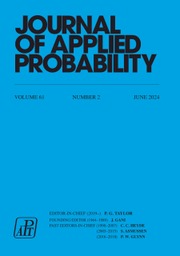Article contents
Comparison results for M/G/1 queues with waiting and sojourn time deadlines
Published online by Cambridge University Press: 30 July 2019
Abstract
This paper considers two variants of M/G/1 queues with impatient customers, which are denoted by M/G/1+Gw and M/G/1+Gs. In the M/G/1+Gw queue customers have deadlines for their waiting times, and they leave the system immediately if their services do not start before the expiration of their deadlines. On the other hand, in the M/G/1+Gs queue customers have deadlines for their sojourn times, where customers in service also immediately leave the system when their deadlines expire. In this paper we derive comparison results for performance measures of these models. In particular, we show that if the service time distribution is new better than used in expectation, then the loss probability in the M/G/1+Gs queue is greater than that in the M/G/1+Gw queue.
MSC classification
- Type
- Research Papers
- Information
- Copyright
- © Applied Probability Trust 2019
References
- 1
- Cited by


